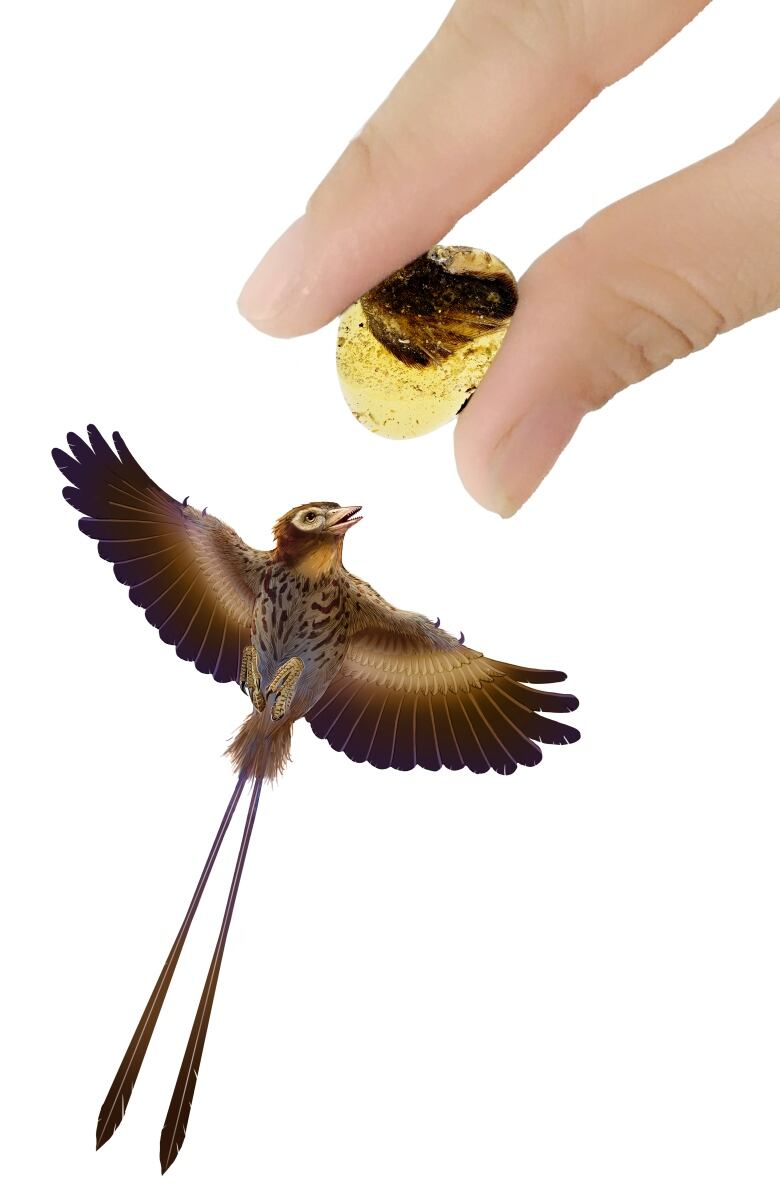Bird wings from Age of Dinosaurs found trapped in amber
Hummingbird-sized baby Enantiornithes birds lived 99 million years ago

Ninety-nine million years ago, two baby birds met an unfortunate end and their severed wings became encased in amber.
Now those beautifully preserved wings, complete with different kinds of feathers of different colours still attached to the skin, are revealing new insights about the evolution of birds.
The amber samples containing the wings were found by Lida Xing, a paleontologist at the China University of Geosciences in Beijing who previously worked and studied in Canada, at an amber market in the Kachin province of Burma, also known as Myanmar,said Ryan McKellar, a scientist at the Royal Saskatchewan Museum who collaborated on the project.
McKellar is the museum's curator of invertebrate paleontology, but has previously studied feathers trapped in amber, so Xing sent him photos of the new finds.
"I was blown away," McKellar said.

Previous feathers found in amber were individual feathers or feather fragments these ones were the entire wings.
The wing-containing amber samples, which were also studded with bubbles and a variety of insects, dated to about 99 million years ago, during the mid-Cretaceous period.
That was about 45 million years after the first birds or avian dinosaurs evolved and 33 million years before the non-avian dinosaurs went extinct. At that time, the birds would have flitted among other dinosaurs in a tropical or subtropical forest that was still dominated by conifers, some of which oozed very sticky resin that hardened into amber.
- Dinosaur feathers found in Alberta amber
- Why birds were the only dinosaurs that survived mass extinction
Based on close examination of the wings with microscopes and CTscans, the researchers believe the preserved wings belonged to baby birds from an extinct group of toothed birds called Enantiornithes, they reported in the journal Nature Communications.
Fossils from this group show they ranged from the size of wrens to the size of starlings, but the wings belonged to chicks that were only the size of hummingbirds, McKellar said.

Most modern baby birds tend to be covered in fuzz and don't grow adult plumage until later. But Enantiornithes chicks were thought to have hatched with fully formed flight feathers and be capable of crawling or flying within a few days of hatching, requiring little parental care, McKellar said. The amber samples appear to confirm that.
And perhaps that precocious independence was a factor in how the chicks died.
Gruesome death
One of the distinctive features of Enantiornithes birds was that they had claws on their wings. In the case of one of the young birds, those claws left drag marks in the amber, suggesting it struggled in the syrupy resin.
"It may have been stuck in the resin while still alive a horrible way to go," McKellar said.
The bones in the wings of the other bird were broken off cleanly at the forearm and had dried out a bit before it became fully encased in resin, suggesting that it may have been eaten by a predator that discarded the bony wings, as many modern raptors do, McKellar suggested.
An examination of the wings show that they were walnut brown on their upper surface and pale or white underneath.
"It looks like they were well-camouflaged," McKellar said.

While fossils of this type of bird have been found, they tend to be squished and highly compressed. In the amber samples, the researchers were able to see how they looked in 3D, including how the feathers attached to the skin follicles.
They found every kind of feather thatmodern birdshave, from down feathers to flight feathers,"with all of the adaptations you'd see with modern birds" and the same patterns of bare and feathered spots.
"The basic pattern, the feather arrangement that we see in many modern birds, was already established by the mid-cretaceous," McKellar said. The amber samples also help fill a gap in the fossil record most Cretaceous bird fossils are from either the early or late Cretaceous, not the middle part of the era.
Despite the amazing preservation of the samples, Xing says it's unlikely that DNA could be extracted from them.
"It's extremely difficult to obtain DNA from amber," he wrote in an email. He added that half the DNA tends to have degraded within a few tens of thousands of years, and noted that these amber samples were 99 million years old, making it unlikely that any DNA remains.












_(720p).jpg)


 OFFICIAL HD MUSIC VIDEO.jpg)
.jpg)



























































































